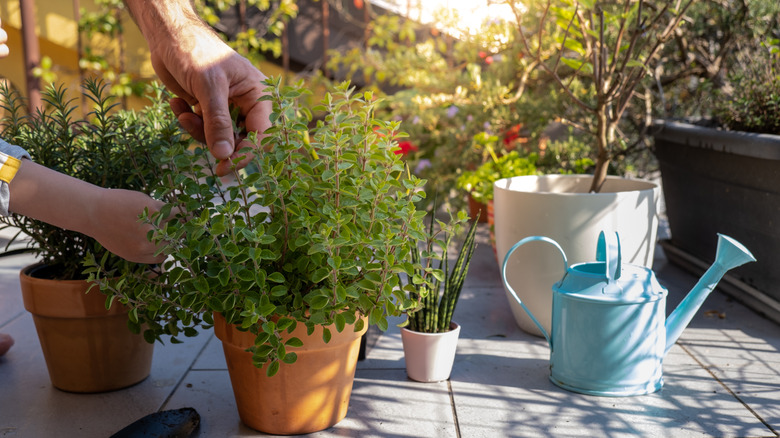The Best Way To Harvest Oregano From Your Garden
We may receive a commission on purchases made from links.
Whether you grow your oregano indoors or out, like most Mediterranean herbs, this aromatic plant needs regular haircuts to thrive. Pruning your oregano plant regularly ensures bushier growth, more leaf than flower, and a sharper flavor. It also encourages airflow — preventing disease and pests. Not knowing where on the plant to make the cut is among the biggest mistakes made when growing oregano. You need to trim the stems on the top of the plant, not closest to the ground.
Few people know that the term "oregano" doesn't actually refer to a plant. Instead, something (a dish, jar of dried herbs, or a species of plant) can taste and smell like oregano. In other words, it's a flavor and scent defined by a chemical compound called carvacrol. Most herb plants sold as oregano in garden centers are, in fact, wild marjoram (origanum vulgare), but you can also find the hardier, more pungent Greek oregano (origanum vulgare hirtum) if you hunt around for it. All that aside, whatever variety of oregano you have growing in your garden, be it wild marjoram, Greek oregano, or something else that has similar growing habits to its cousins — think full sun, good drainage, and lackluster soil — and, as such, like harvesting needs.
Perfect your technique
Instead of setting your snips close to the ground as you would with, say, parsley, bring your hand up about one-third from the top of the stem and make your cut. Drop the clipping into a bowl or basket — like this gorgeous handmade wicker herbalist's basket, $110.00 on Etsy — lightly spritzed with water, and continue harvesting. Having the right tools for the job makes all the difference. Stems smooshed flat from blunt scissors are susceptible to disease. Make sure you use a pair of new or freshly sharpened, clean secateurs or pruning shears. Walmart has Nevlers Garden Pruning Shears, which work well for plant stems up to 8 millimeters thick, for $12.99. Don't forget to don a pair of gardening gloves — carvacrol has been found to cause skin irritation on some occasions.
To prepare the collected oregano for use in cooking or non-culinary uses, simply run your thumb and forefinger down each stem from the tip to the base. This will gently strip off the leaves, leaving the branch to be discarded or, ideally, added to your indoor composting bin. You can also dry your oregano. Tie the stems together with string and hang them in a cool, dry, and dark spot in your home. Alternatively, dry the leaves in an electric dehydrator.
